Control of Single-Phase Electrolytic Capacitor-Less Isolated Converter for DC Low Voltage Residential Networks
Abstract
1. Introduction
2. Converter Model and Control
2.1. Description of the Proposed Converter
2.2. Sliding Mode Control for Voltage
2.3. Control Using the Lyapunov Direct Method of Stability to Obtain the Reference for Current
2.4. Lyapunov Control for Current to Track the Reference
2.5. Sliding Mode Control for Voltage to Track the Reference
3. Simulation Results
Characteristics of the Converter
4. Experimental Results
4.1. Converter Prototype and Experimental Setup
4.2. Digital Control Implementation
4.3. Lab Prototype Results
5. Conclusions
Author Contributions
Funding
Conflicts of Interest
References
- Marzband, M.; Ardeshiri, R.R.; Moafi, M.; Uppal, H. Distributed generation for economic benefit maximization through coalition formation-based on Game Theory. Int. Trans. Electr. Energy Syst. 2017, 27, e2313. [Google Scholar] [CrossRef]
- Walter, D.; Mariacristina, R.; Dario, Z. Hybrid photovoltaic system control for enhancing sustainable energy. In Proceedings of the IEEE Power Engineering Society Summer Meeting, Chicago, IL, USA, 21–25 July 2002; Volume 1, pp. 134–139. [Google Scholar]
- Han, Y.; Chen, W.; Li, Q. Energy Management Strategy Based on Multiple Operating States for a Photovoltaic/Full Cell/Energy Storage DC Microgrid. Energies 2017, 10, 136. [Google Scholar] [CrossRef]
- Gerber, D.L.; Vossos, V.; Feng, W.; Khandekar, A.; Marnay, C.; Nordman, B. A simulation based comparison of AC and DC power distribution networks in buildings. In Proceedings of the IEEE Second International Conference on DC Microgrids (ICDCM), Nuremburg, Germany, 27–29 June 2017; pp. 588–595. [Google Scholar]
- Chauhan, R.K.; Rajpurohit, B.S.; Hebner, R.E.; Singh, S.N.; Gonzalez-Longatt, F.M. Voltage Standardization of DC Distribution System for Residential Buildings. J. Clean Energy Technol. 2015, 4, 167–172. [Google Scholar] [CrossRef]
- Li, W.; Mou, X.; Zhou, Y.; Marnay, C. On voltage standards for DC home microgrids energized by distributed sources. In Proceedings of the 7th International Power Electronics and Motion Control Conference (IPEMC), Harbin, China, 2–5 June 2012; Volume 3, pp. 2282–2286. [Google Scholar]
- Arunkumar, G.; Devaraj, E.; Padmanaban, S.; Hossain, E.; Leonowicz, Z.; Joseph, P.K. DC Grid for Domestic Electrification. Energies 2019, 12, 2157. [Google Scholar] [CrossRef]
- Pratt, A.; Kumar, P.; Aldridge, T.V. Evaluation of 400V DC distribution in telco and data centers to improve energy efficiency. In Proceedings of the INTELEC 29th International Telecommunications Energy Conference, Rome, Italy, 30 September–4 October 2007; pp. 32–39. [Google Scholar]
- Public Overview of the Emerge Alliance Data/Telecom Center Standard; EMerge Alliance: San Ramon, CA, USA, 2012; Available online: http://www.directpowertech.com/docs/PublicOverviewoftheEMergeAllianceDataTelecom_21298_2.pdf (accessed on 31 July 2020).
- Priyadharshini, G.; Nandhini, N.R.; Shunmugapriya, S.; Ramaprabha, R. Design and simulation of smart sockets for domestic DC distribution. In Proceedings of the International Conference on Power and Embedded Drive Control (ICPEDC), Chennai, India, 16–18 March 2017; pp. 426–429. [Google Scholar]
- Shivakumar, A.; Normark, B.; Welsch, M. Household DC Networks: State of the Art and Future Prospects; Insight_E. 2015. Available online: https://www.sun-connect-news.org/fileadmin/DATEIEN/Dateien/New/DCnetworks_Final.pdf (accessed on 31 July 2020).
- López-Santos, O.; Cabeza-Cabeza, A.J.; García, G.; Martínez-Salamero, L. Sliding Mode Control of the Isolated Bridgeless SEPIC High Power Factor Rectifier Interfacing an AC Source with a LVDC Distribution Bus. Energies 2019, 12, 3463. [Google Scholar] [CrossRef]
- Lin, X.; Wang, F.; Iu, H.H.C. A New Bridgeless High Step-up Voltage Gain PFC Converter with Reduced Conduction Losses and Low Voltage Stress. Energies 2018, 11, 2640. [Google Scholar] [CrossRef]
- Singh, B.; Chandra, A.; Al-Haddad, K.; Pandey, A.; Kothari, D.P. A review of single-phase improved power quality ac~dc converters. IEEE Trans. Ind. Electron. 2003, 50, 962–981. [Google Scholar] [CrossRef]
- Reimensnyder, N.; Weise, N. Voltage control of a single phase, single-stage, isolated AC-DC converter. In Proceedings of the 2013 IEEE Transportation Electrification Conference and Expo (ITEC), Detroit, MI, USA, 16–19 June 2013; pp. 1–5. [Google Scholar]
- Agarwal, T.; Bhardwaj, S.K.; Katara, K.K.; Pareta, R. A Review and Comparative Study on Single-Phase Ac-Dc Converters for Their High Frequency Applications. In Proceedings of the International Conference Proceeding ICCCT, Allahabad, India, 24–26 November 2017; Available online: http://www.ijcrt.org/papers/IJCRTICCC002.pdf (accessed on 31 July 2020).
- Lin, B.; Hwang, T. Single phase rectifier with high power factor in continuous and discontinuous conduction mode. In Proceedings of the IEEE International Symposium on Industrial Electronics, Dubrovnik, Croatia, 10–14 July 1995; Volume 1, pp. 421–426. [Google Scholar]
- Vossos, E. Optimizing Energy Savings from “Direct-DC” in US Residential Buildings; Ernest Orlando Lawrence Berkeley National Laboratory: Berkeley, CA, USA, 2011. [Google Scholar]
- Vossos, V.; Garbesi, K.; Shen, H. Energy savings from direct-DC in U.S. residential buildings. Energy Build. 2014, 68, 223–231. [Google Scholar] [CrossRef]
- Savage, P.; Nordhaus, R.R.; Jamieson, S.P. Dc Microgrids: Benefits and Barriers. In From Silos to Systems: Issues in Clean Energy and Climate Change; Yale School of Forestry & Environmental Studies: New Haven, CT, USA, 2010; pp. 51–66. [Google Scholar]
- Rodriguez-Otero, M.A.; O’Neill-Carrillo, E. Efficient Home Appliances for a Future DC Residence. In Proceedings of the 2008 Energy 2030 Conference, Atlanta, Georgia, 17–18 November 2008; Volume 6, pp. 17–18. [Google Scholar]
- Costa, P.B.; Silva, J.F.; Pinto, S.F. Experimental evaluation of SiC MOSFET and GaN HEMT losses in inverter operation. In Proceedings of the IEEE IECON 2019-45th Annual Conference of the IEEE Industrial Electronics Society, Lisbon, Portugal, 14–17 October 2019; pp. 6595–6600. [Google Scholar]
- Watanabe, H.; Itoh, J.-I.; Koike, N.; Nagai, S. PV Micro-Inverter Topology Using LLC Resonant Converter. Energies 2019, 12, 3106. [Google Scholar] [CrossRef]
- Santos, N.; Silva, J.F.; Soares, V. High-Frequency Transformer Isolated AC-DC Converter for Resilient Low Voltage DC Residential Grids. In Technological Innovation for Resilient Systems; Springer: Cham, Switzerland, 2018; pp. 147–155. [Google Scholar]
- Zhang, H.; Li, X.; Ge, B.; Balog, R.S. Capacitance, dc Voltage Utilizaton, and Current Stress: Comparison of Double-Line Frequency Ripple Power Decoupling for Single-Phase Systems. IEEE Ind. Electron. Mag. 2017, 11, 37–49. [Google Scholar] [CrossRef]
- Singh, B.P.; Singh, S.; Chandra, A.; Al-Haddad, K. Comprehensive Study of Single-Phase AC-DC Power Factor Corrected Converters with High-Frequency Isolation. IEEE Trans. Ind. Inform. 2011, 7, 540–556. [Google Scholar] [CrossRef]
- Shamshuddin, M.A.; Rojas, F.; Cárdenas, R.; Pereda, J.; Diaz, M.; Kennel, R. Solid State Transformers: Concepts, Classification, and Control. Energies 2020, 13, 2319. [Google Scholar] [CrossRef]
- Licea, M.A.R.; Pinal, F.J.P.; Perez, J.C.N.; Herrera, C. Nonlinear Robust Control for Low Voltage Direct-Current Residential Microgrids with Constant Power Loads. Energies 2018, 11, 1130. [Google Scholar] [CrossRef]
- Paraíso, G.M.; Silva, J.F.; Pinto, S.F. Control strategies for low voltage DC residencial grids with constant power loads. In 2018 International Young Engineers Forum (YEF-ECE); IEEE: New York, NY, USA, 2018; pp. 67–72. [Google Scholar]
- Silva, J.F.; Pinto, S.F. Linear and Nonlinear Control of Switching Power Converters. In Power Electronics Handbook, 4th ed.; Butterworth-Heinemann: Oxford, UK, 2017; pp. 1141–1220. [Google Scholar]
- Silva, J.F. Sliding Mode Control of Voltage Sourced Boost-Type Reversible Rectifiers. In Proceedings of the IEEE/ISIE’97 Conference, Guimarães, Portugal, 7–11 July 1997; IEEE: New York, NY, USA, 1997; Volume 2, pp. 329–334. [Google Scholar]
- Martins, J.F.; Pires, A.J.; Silva, F.A. A novel and simple current controller for three-phase PWM power inverters. IEEE Trans. Ind. Electron. Spec. Sect. PWM Curr. Regul. 1998, 45, 802–805. [Google Scholar] [CrossRef]
- Santos, N.; Silva, F.A.; Santana, J. Sliding Mode Control of Unified Power Quality Conditioner for 3 Phase 4 Wire Systems. In Doctoral Conference on Computing, Electrical and Industrial Systems; Springer: Berlin/Heidelberg, Germany, 2014; pp. 443–450. [Google Scholar]
- Yasin, A.R.; Ashraf, M.; Bhatti, A.I. Fixed Frequency Sliding Mode Control of Power Converters for Improved Dynamic Response in DC Micro-Grids. Energies 2018, 11, 2799. [Google Scholar] [CrossRef]
- Serna, S.; González-Montoya, D.; Ramos-Paja, C.A. Control of a Charger/Discharger DC/DC Converter with Improved Disturbance Rejection for Bus Regulation. Energies 2018, 11, 594. [Google Scholar] [CrossRef]
- Tan, Y.; Chang, J.; Tan, H. Advanced Motion Control Scheme with Integrator backstepping: Design and Analysis. In Proceedings of the 2000 IEEE 31st Annual Power Electronics Specialists Conference, Galway, Ireland, 23–23 June 2000. [Google Scholar]
- Escudero, M.; Kutschak, M.-A.; Meneses, D.; Rodriguez, N.; Morales, D.P. A Practical Approach to the Design of a Highly Efficient PSFB DC-DC Converter for Server Applications. Energies 2019, 12, 3723. [Google Scholar] [CrossRef]
- Pindoriya, R.M.; Pindoriya, N.M.; Rajendran, S. Simulation of DC/DC converter for DC nano-grid integrated with solar PV generation. In 2015 IEEE Innovative Smart Grid Technologies—Asia (ISGT ASIA); IEEE: New York, NY, USA, 2015; pp. 1–6. [Google Scholar]
- Rigogiannis, N.; Voglitsis, D.; Jappe, T.; Papanikolaou, N. Voltage Transients Mitigation in the DC Distribution Network of More/All Electric Aircrafts. Energies 2020, 13, 4123. [Google Scholar] [CrossRef]
- Kim, M.; Lee, S.G.; Bae, S. Decentralized Power Management for Electrical Power Systems in More Electric Aircrafts. Electronics 2018, 7, 187. [Google Scholar] [CrossRef]


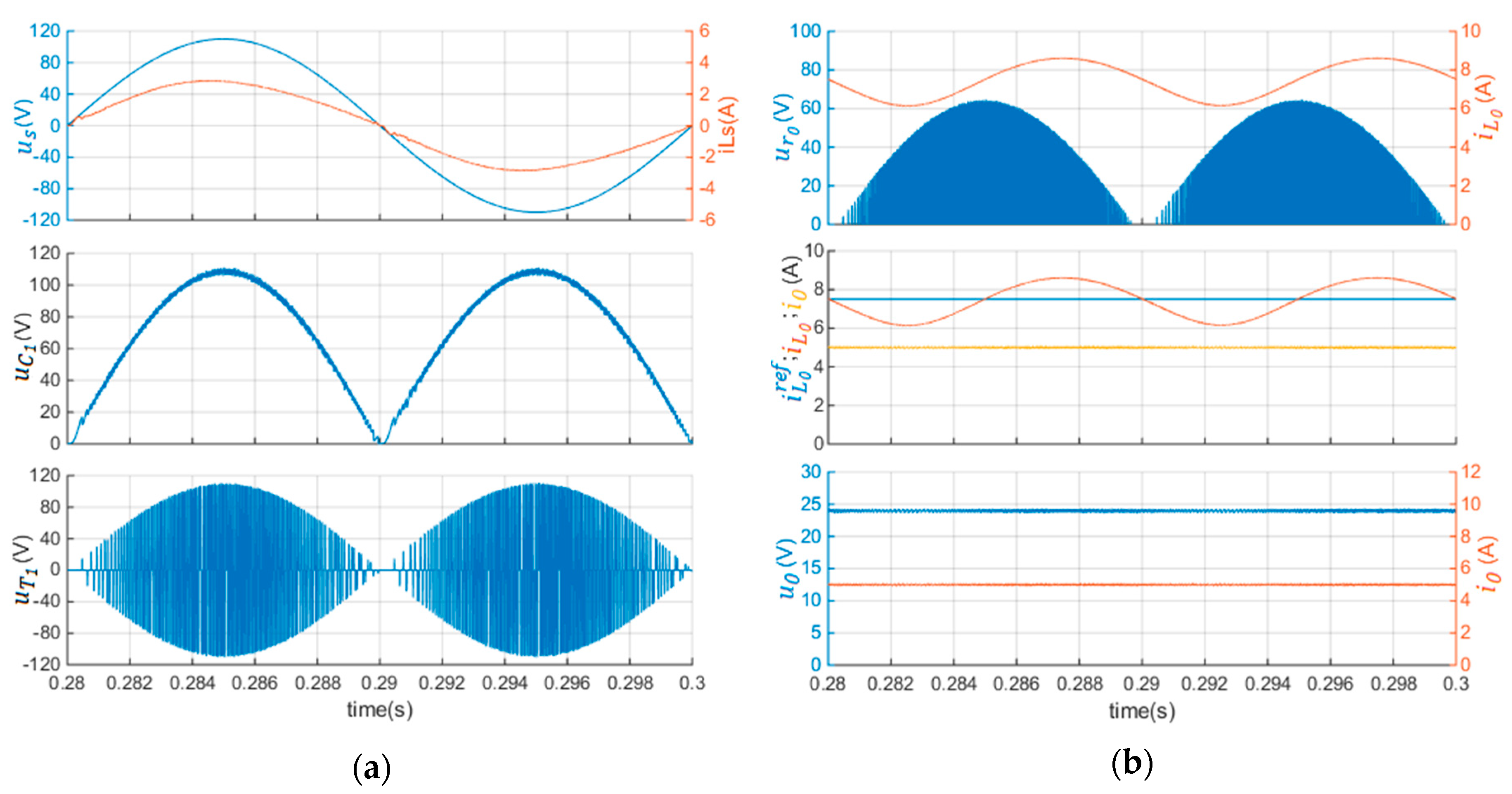


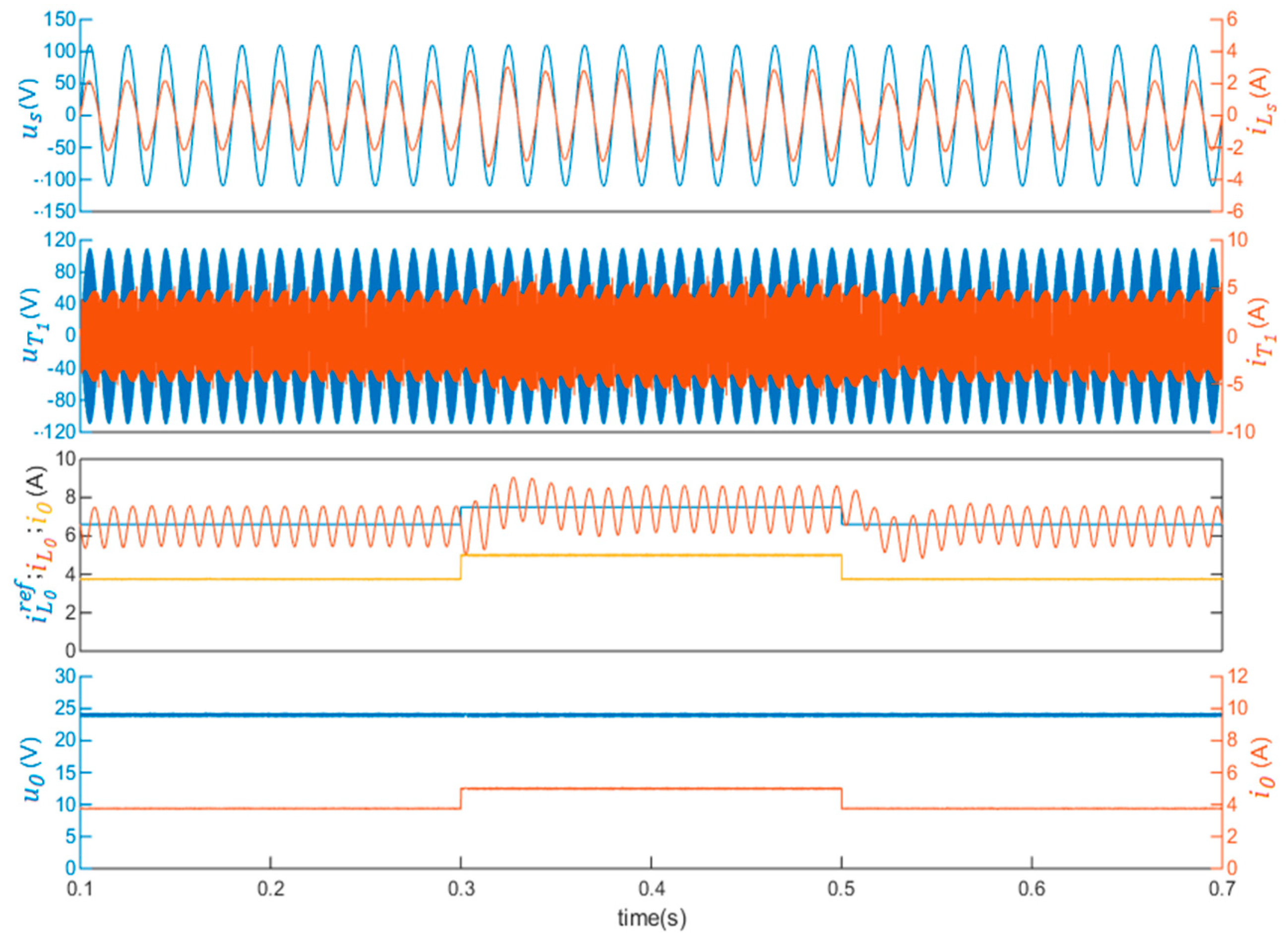
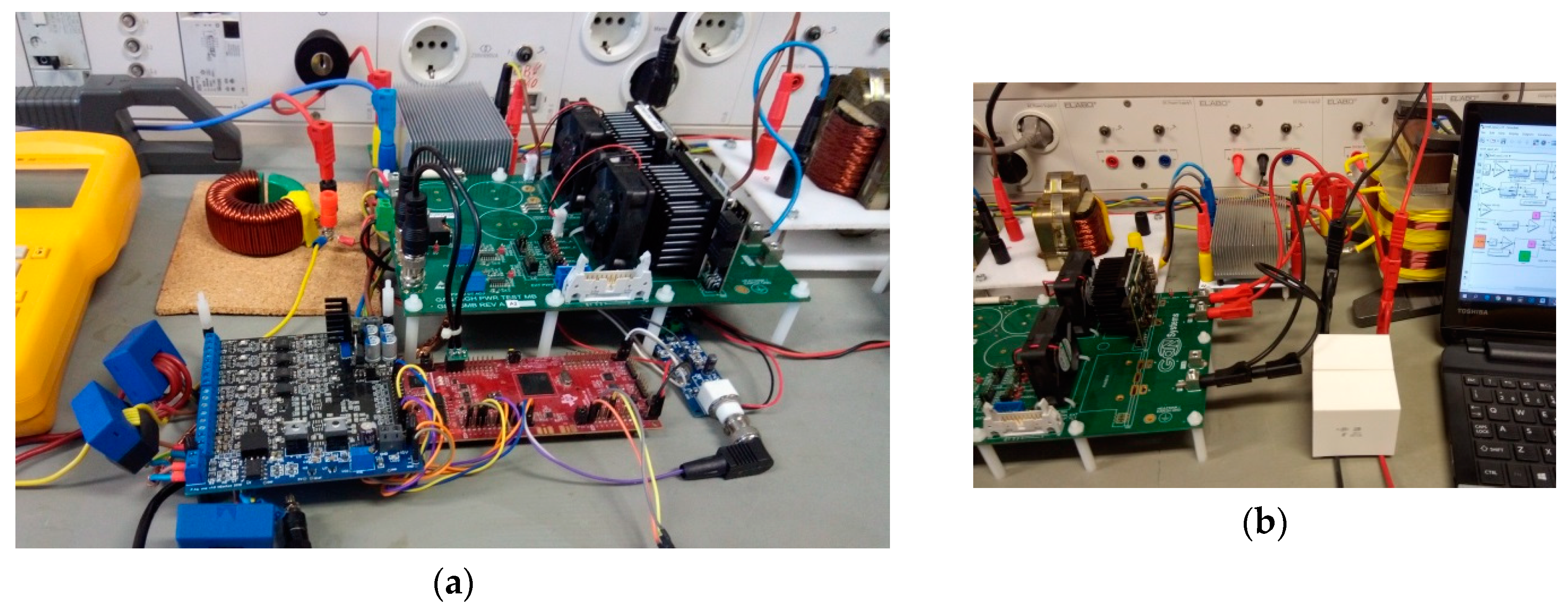
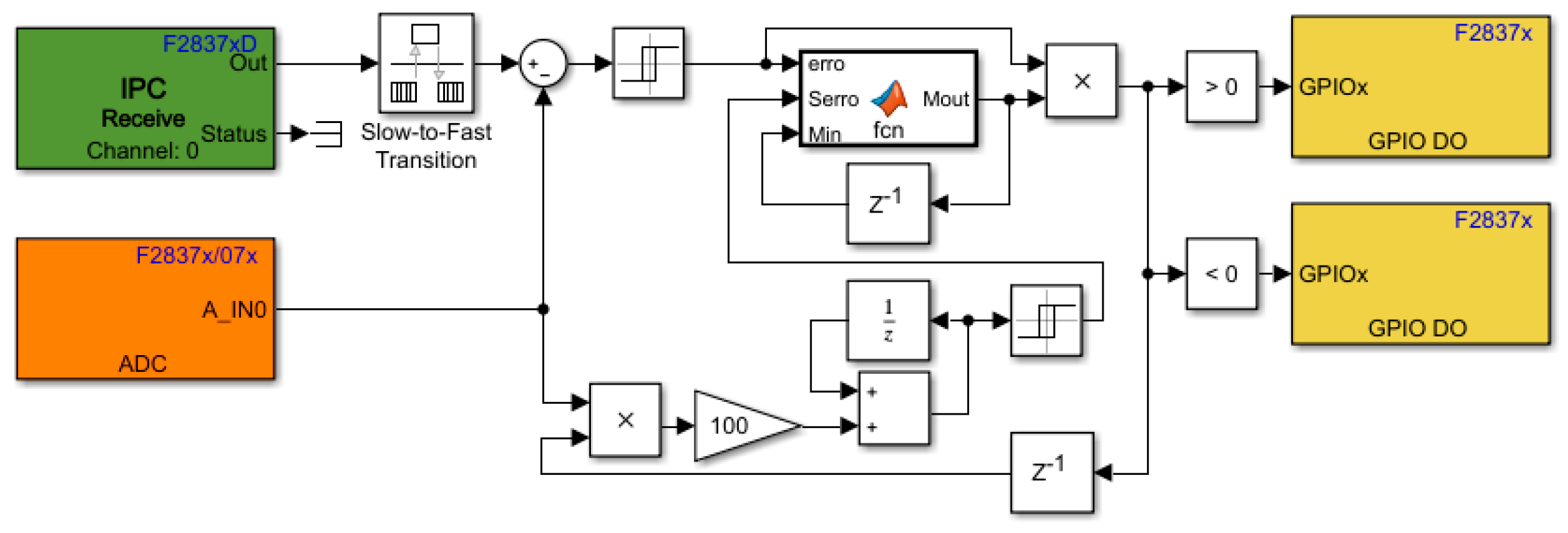
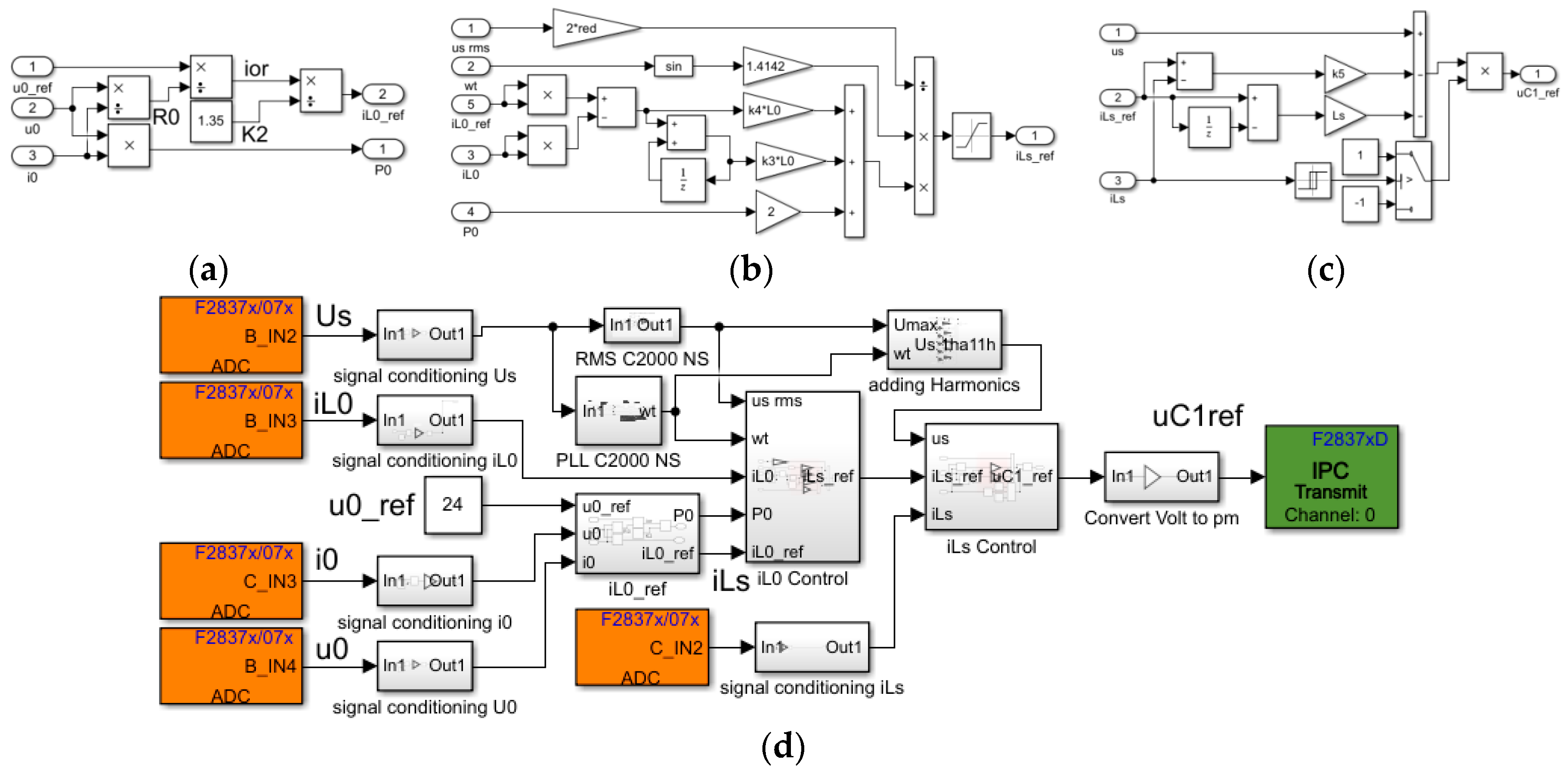
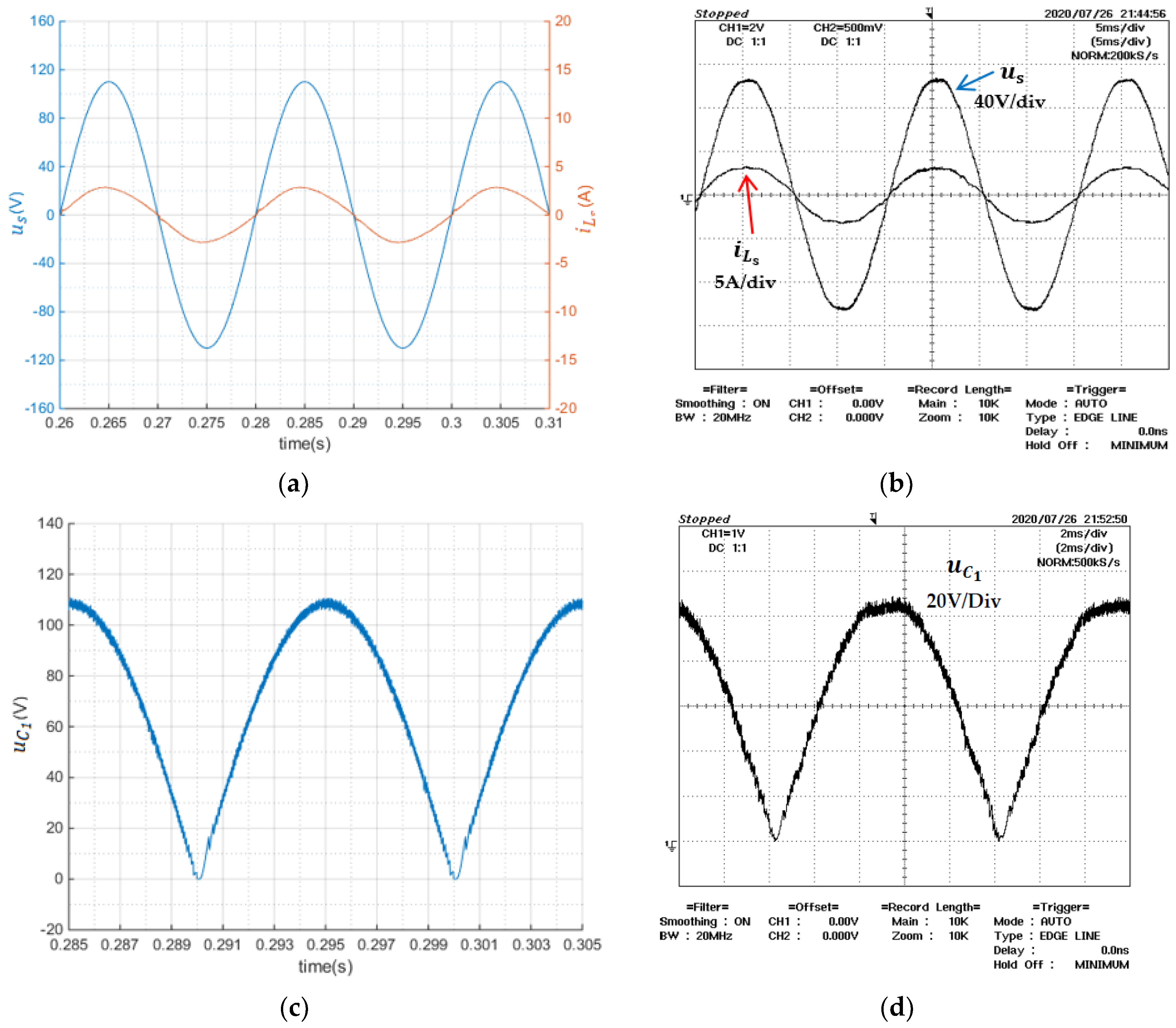

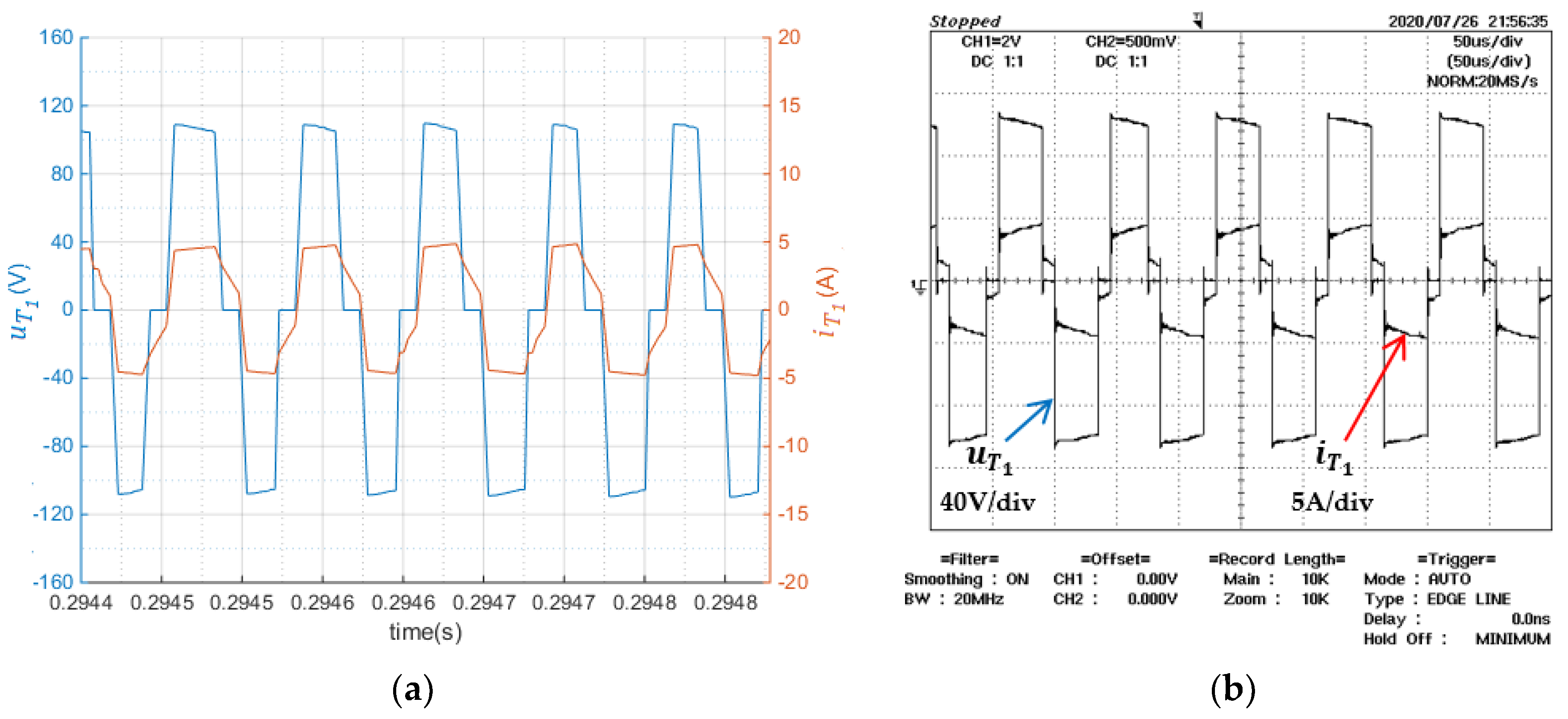
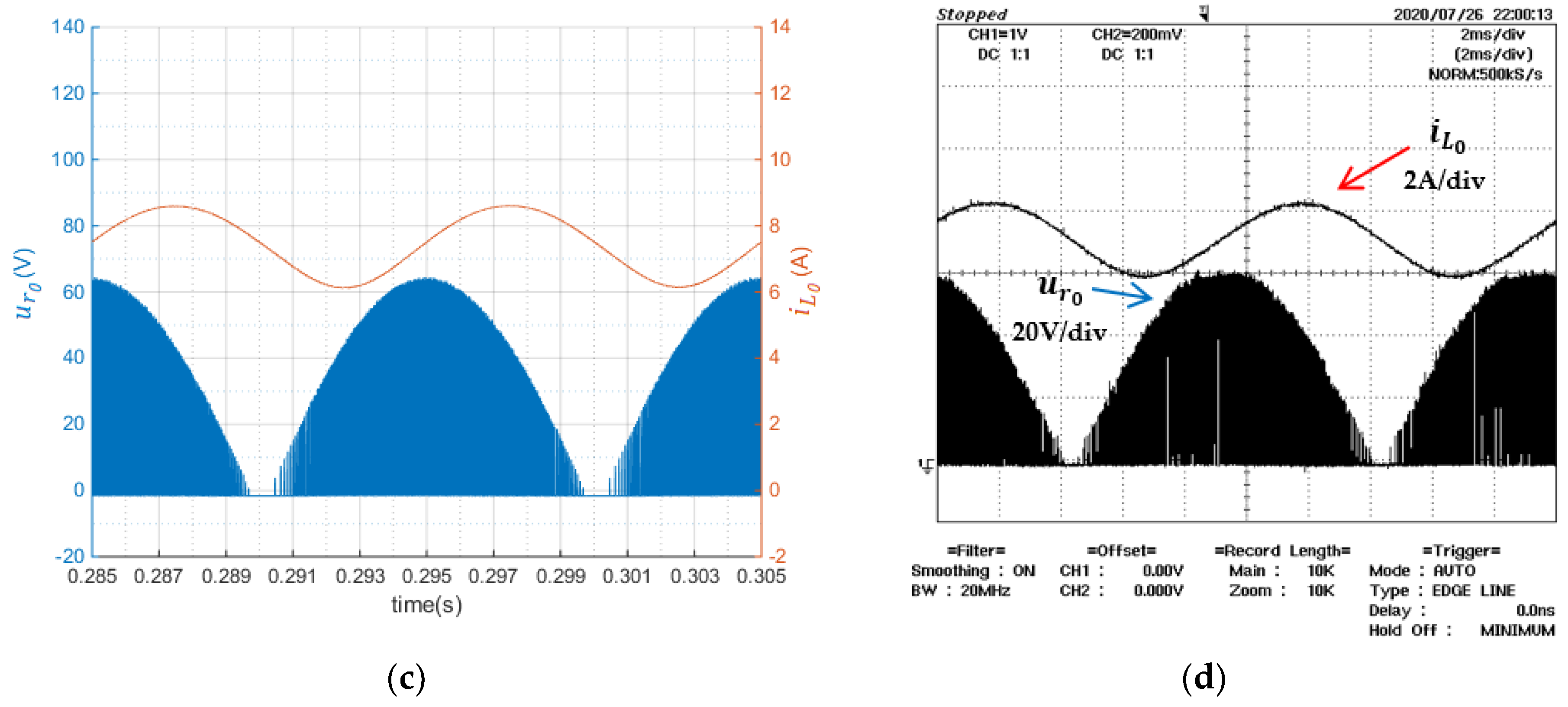
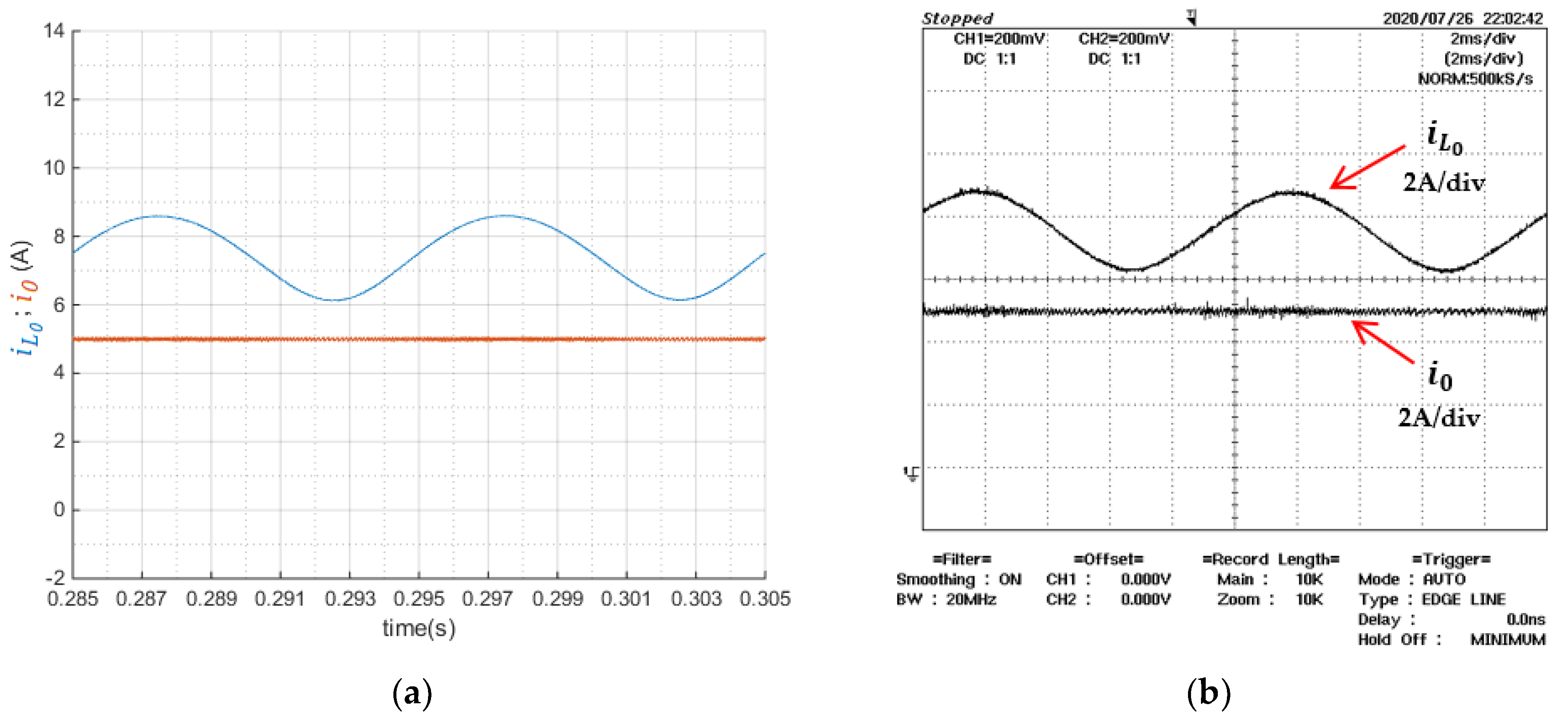
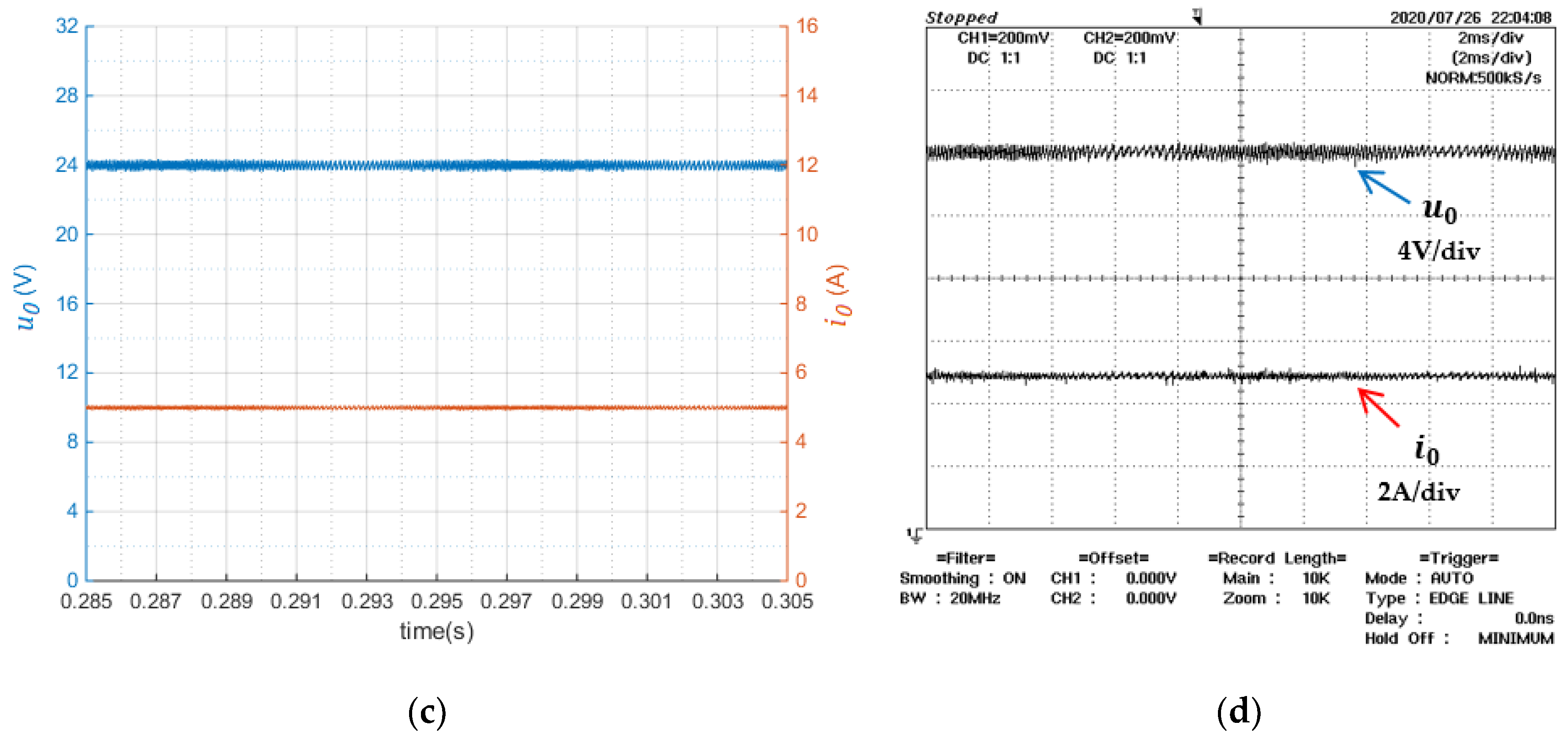
| Symbol | Description | Value | Symbol | Description | Value |
|---|---|---|---|---|---|
| AC peak voltage | 110 V | 4 V | |||
| AC frequency | 50 Hz | 0.1 A | |||
| DC voltage | 24 V | 0.4 V | |||
| Power of load | 120 W | 3 A | |||
| Proposed efficiency | 90 % | n | Transformer ratio | 1.6 | |
| Input inductor | 1.2 mH | Output inductor | 25 mH | ||
| Input capacitor | 8 µF | DC-bus capacitor | 200 µF |
© 2020 by the authors. Licensee MDPI, Basel, Switzerland. This article is an open access article distributed under the terms and conditions of the Creative Commons Attribution (CC BY) license (http://creativecommons.org/licenses/by/4.0/).
Share and Cite
Santos, N.; Silva, J.F.; Soares, V. Control of Single-Phase Electrolytic Capacitor-Less Isolated Converter for DC Low Voltage Residential Networks. Electronics 2020, 9, 1401. https://doi.org/10.3390/electronics9091401
Santos N, Silva JF, Soares V. Control of Single-Phase Electrolytic Capacitor-Less Isolated Converter for DC Low Voltage Residential Networks. Electronics. 2020; 9(9):1401. https://doi.org/10.3390/electronics9091401
Chicago/Turabian StyleSantos, Nelson, J. Fernando Silva, and Vasco Soares. 2020. "Control of Single-Phase Electrolytic Capacitor-Less Isolated Converter for DC Low Voltage Residential Networks" Electronics 9, no. 9: 1401. https://doi.org/10.3390/electronics9091401
APA StyleSantos, N., Silva, J. F., & Soares, V. (2020). Control of Single-Phase Electrolytic Capacitor-Less Isolated Converter for DC Low Voltage Residential Networks. Electronics, 9(9), 1401. https://doi.org/10.3390/electronics9091401






